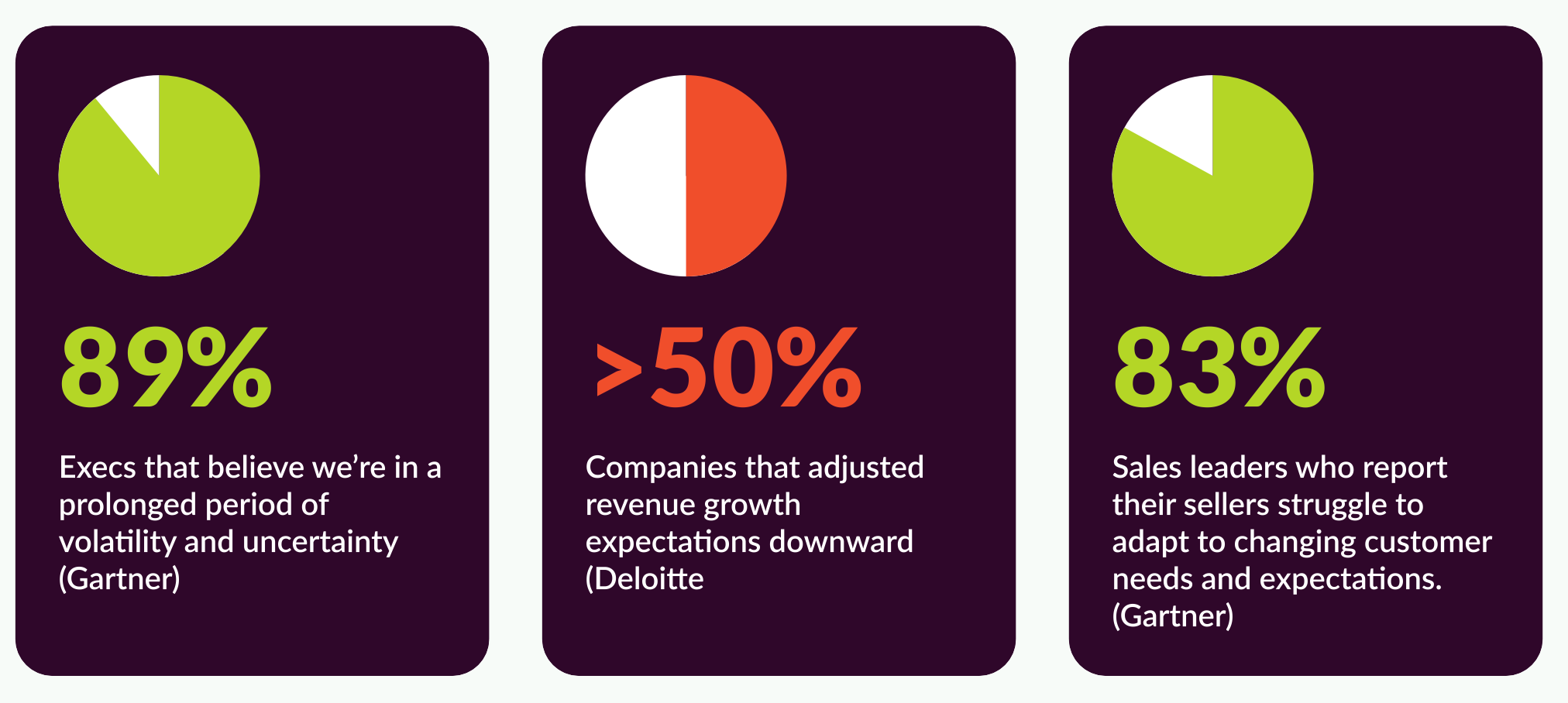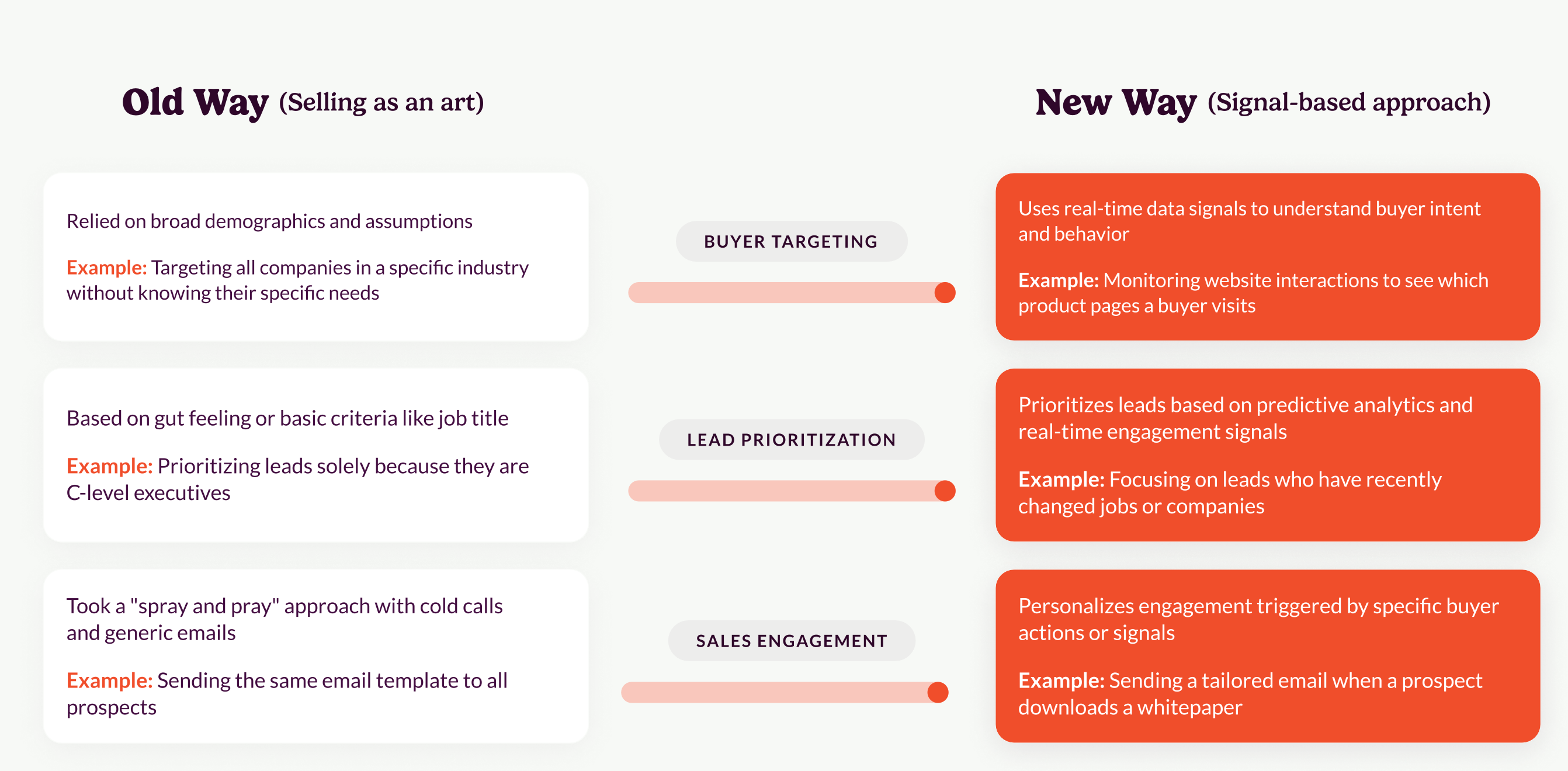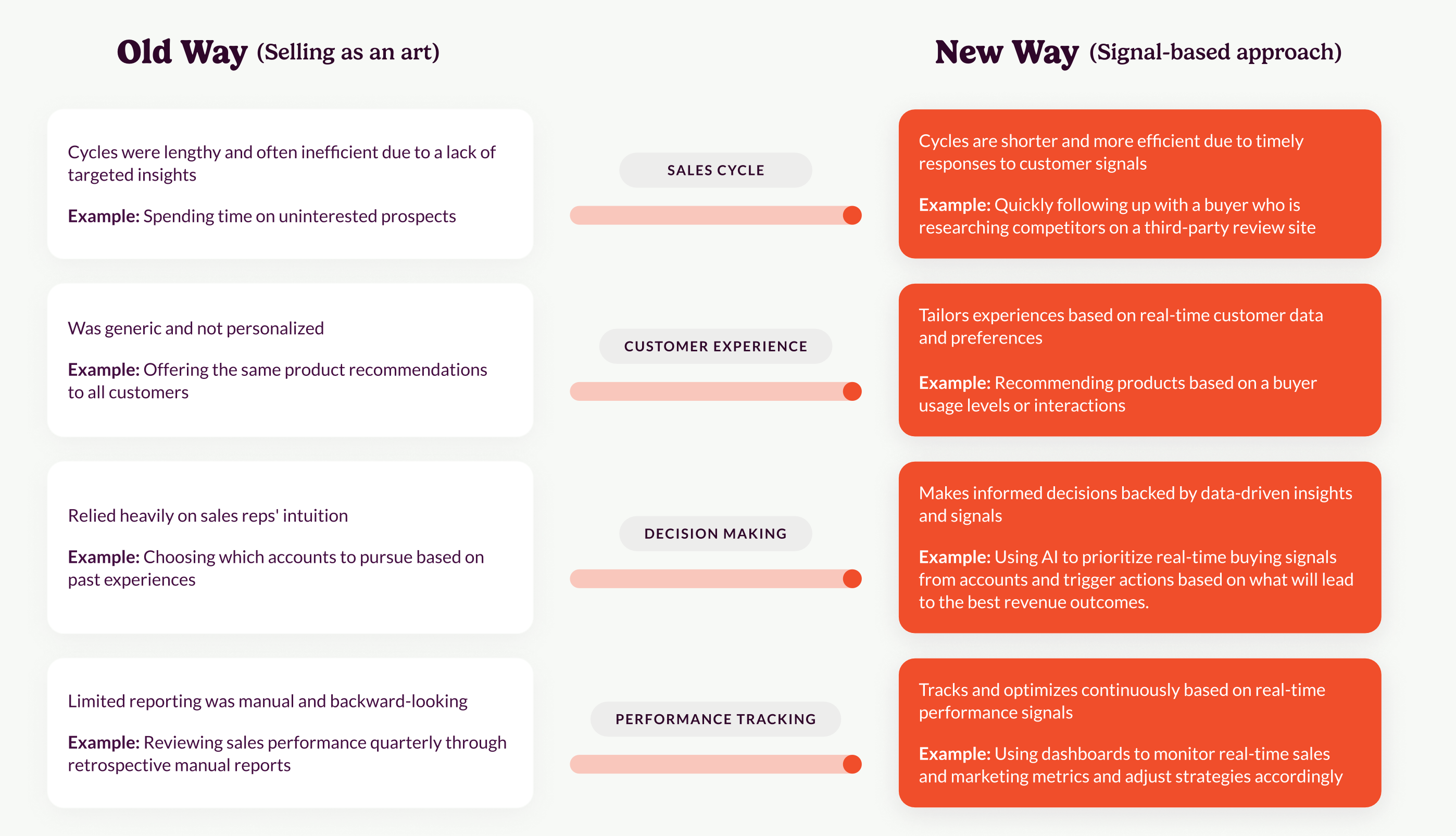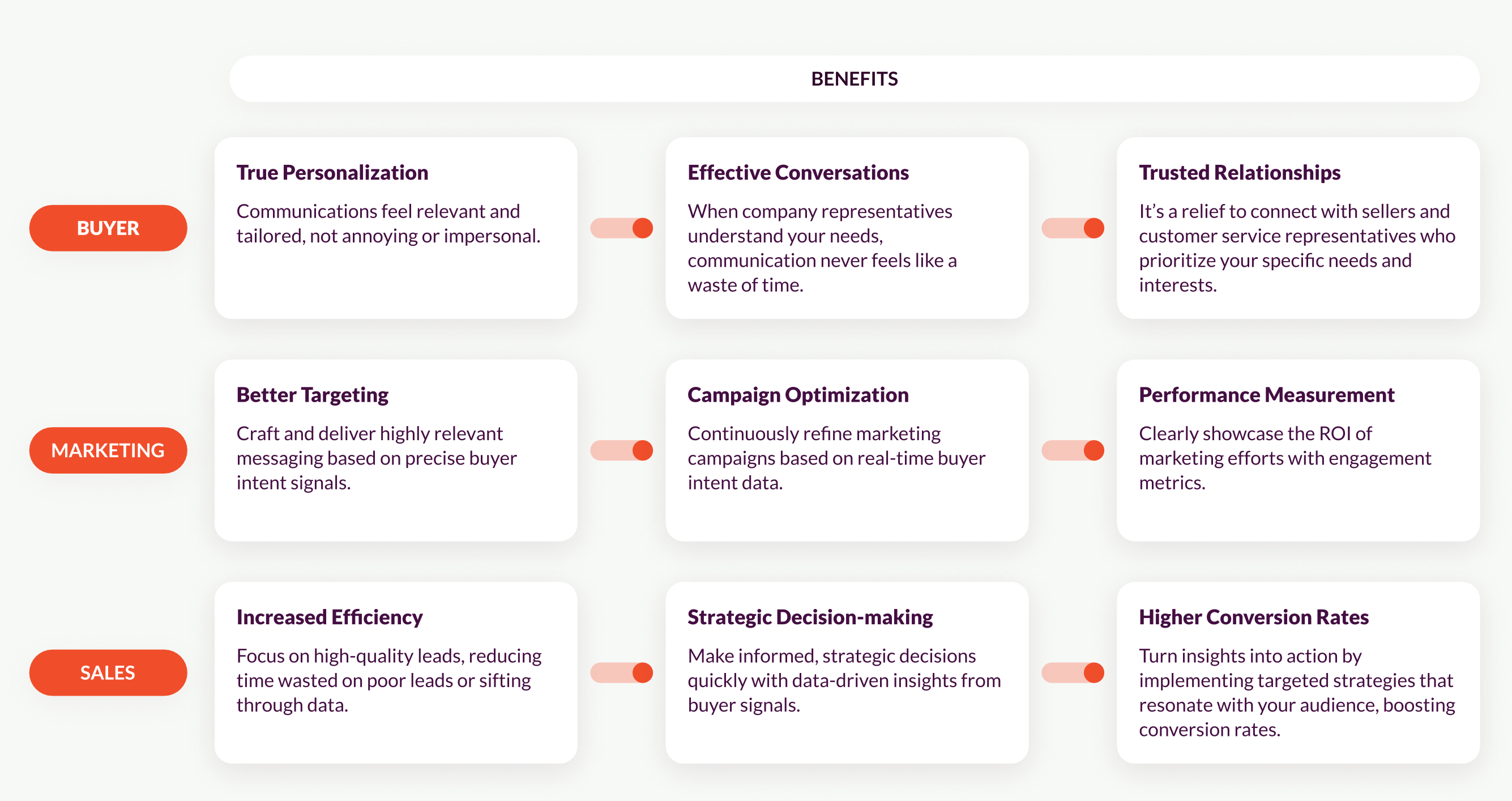Your Guide To B2B Buying Signals: What They Are & How To Use Them
Published:

A better way to connect with buyers
Revenue leaders everywhere are feeling the Great Growth Squeeze, and it’s wreaking havoc on predictable revenue growth.

Your front-line sales and marketing teams are working harder than ever to bring back the good old days. But they’re relying on tactics and a sprawl of tools built for a different economy and buyer.
You know the drill:
- Buying committees are bigger than ever (an average of 9 people).
- When buyers talk to your team, they are well into their purchase journey—yet it still takes them longer to make their final decision.
- And they care deeply about the experience you provide; 80% say it’s as important as your products or services.
Unfortunately, most organizations are a long way from providing the experience customers expect.
Revenue teams are pumping out content and emails but are getting few replies. They’re engaging with leads but not fast enough or with the right message. They’re fighting churn but missing the mark.
The signal-based approach to revenue generation solves these challenges.
Signal-based go-to-market fundamentally shifts your relationship with buyers. From the first touch, buying signals help your team identify people who will be receptive to your engagement and provide insight into what they want and when. By tracking and responding to buying signals, your GTM teams can coordinate to provide top-notch buyer experiences and generate durable revenue.
This guide will give you a comprehensive overview of how your team can efficiently use buying signals to raise the quality of your pipeline and restore revenue predictability.
First, what are buying signals?
Buying Signals
- A behavior or action by a buyer that indicates interest, including, but not limited to, website interactions, social media engagements, ad clicks, and points of contact with chatbots, sales team, or customer support.
Signal-based go-to-market
- A responsive technique centered on identifying and engaging the highest-potential buyers based on specific triggers, or signals, of buyer intent.
Only 5% of your target audience is in market at any given time.1 Buying signals give you a reliable way to identify that 5%. They replace speculation with information, adding science to the art of selling.
Prospective buyers leave digital footprints (a.k.a., buying signals) long before they decide to contact a vendor. With the right tools, you can make the previously invisible (website visits, social media engagement, ad clicks, and more) visible and easily accessible for the GTM team.
More than that, the right Revenue Orchestration Platform can tell your sellers what those buying signals mean, exactly when and why to reach out, and the right message to move deals forward. Because true personalization is more than assumptions based on broad categories like demographics or geography.
Personalization is often designed using existing customer data as a guide. But existing customer data is often biased toward information about who a customer is—aspects of their identity—versus what they actually need.
Before we go much further, let’s look at how signal-based go-to-market improves on the old way of doing things.
Old GTM tactics versus the signal-based approach


Why are buying signals important?
Buyers know that companies collect more user and buyer data than ever. As a result, expectations for highly personalized and continuous engagement have skyrocketed. But in reality, making sense of all that data poses a huge challenge for sales, marketing, and customer success teams. All the data in the world won’t help if it doesn’t support data-driven decisions about what to do next.
By scanning for real-time signals of interest, teams can respond to prospects, buyers, and customers with relevant and truly personalized communications. Instead of hoping that the companies you reach out to will be interested, signals show you relatively definitively who is and guide your next action in the context of their activity. For example, when a prospect spends time on a free trial page but doesn’t sign up, that could raise a flag that a seller should make contact.
The benefits of a signal-based program extend beyond individual engagements, touching every aspect of revenue operations.
[While] the large majority of B2B buyers (82%) want personalized communications from all brands or brands they give permission to...nearly 60% block the brand when they find it invasive, and 44% block the brand when it communicates in a way they find irrelevant or annoying.


Signals you should be capturing
84% of deals are won or lost before providers know they even exist.
Intent signals let revenue teams regain control of the buying cycle. By tracking the right signals, you can identify prospective buyers, understand them, and win them over.
Many analytics and intelligence tools exist to help gather information about who’s engaging with your brand, who may be entering the market for your products, and what actions they’re taking in real time. Some tools even log information about anonymous visitors and supplement it with additional information as they engage with you more.
These six broad categories of signals drive a well-rounded signal- based selling program:
Behavioral Signals
Signals related to an individual’s general engagement with your brand or competitors
- Website visits: Tracking which pages prospects visit, how often, and for how long
- Email interactions: Monitoring open rates, click- through rates, and response rate
- Social media engagement: Observing likes, shares, comments, and mentions related to your brand
- Competitor interactions: Monitoring mentions of competitors and interactions with their content
- Referral sources: Identifying where your traffic is coming from and which channels are most effective
Intent Signals
High-intent signals related to an individual’s engagement with your brand
- Content downloads: Keeping track of eBooks, whitepapers, and other resources downloaded by prospects
- Product page views: Noting which product pages a prospect has viewed and the frequency of visits
- Trial sign-ups: Identifying who signs up for trials and the extent of their engagement during the trial period
- Engagement with marketing campaigns: Tracking how prospects interact with various marketing initiatives
- Event participation: Tracking attendance and engagement at webinars, conferences, and other events
Firmographic Signals
Data about the companies in your ideal customer profile (ICP) or companies whose employees are engaging with you
- Company size: Understanding the scale of the companies interacting with your brand
- Industry: Recognizing which industries are most interested in your offerings
- Location: Geographical data that might influence sales strategies
Technographic Signals
Intelligence about technologies your prospects and customers are using
- Technology stack usage: Knowing what technologies your prospects are currently using
- Software adoption: Tracking which software solutions are being adopted by target accounts
Your Own Signals
Custom insights that your team identifies as relevant to your revenue operations
- Product-led signals: Insights from product usage data, such as frequency and depth of use
- Customer triggers: Specific actions or events within customer accounts that indicate potential opportunities (e.g., a champion leaving the company, a new funding round, etc.)
- Customizable Signal Tracking: The ability to customize which signals you track and how they are weighted, allowing for tailored sales strategies
Putting together a signal-based program
In an era where every click, like and share can be monitored, businesses can easily drown in a sea of data, struggling to discern what is relevant.
Not all signals are equal and context matters. The exact combination of signals you track and how you respond to each of them will be unique to your business. You can decide how to weigh signals that indicate higher intent than others. You can also layer relevant buying signals on top of each other to gain additional context around the likelihood of buying and how to respond.
Of course, you can’t expect your team to sift through all this data. That would just add to their workload and cause confusion.
A Revenue Orchestration Platform helps you tailor a program that automatically and intelligently turns data points into actionable insights using AI.
Unify and act on signals with a Revenue Orchestration Platform
Revenue Orchestration Platforms connect insights to action by providing both structured and unstructured (or dynamic) guidance on what to prioritize next.
Since signal-based revenue generation depends on vast amounts of data from a wide variety of sources, you need a unified Revenue Orchestration Platform to manage your signal-based program.
Sellers are already using an average of 10 tools to close deals,7 and jumping across that many systems leads to system fatigue. If you’ve ever lost your train of thought between one room and the next, you’ve experienced the “doorway effect.” This cognitive hiccup also happens when people navigate from one computer window to another. It’s no wonder that 77% of sellers report struggling to complete their assigned tasks.8
A Revenue Orchestration Platform simplifies revenue processes by integrating all necessary tools and buyer intent data into a single interface. This unification helps your team capture and act on signals efficiently, boosting productivity and buyer engagement.
Consolidating the workflow onto one integrated platform delivers enormous benefits:
1) Better buyer (and revenue team) experiences:
Your marketing, sales, and customer success teams can focus on relationship-building with the aid of real-time insights, helpful context, and AI-driven next-best-action recommendations.
A Revenue Orchestration Platform brings it all into one user- friendly workflow. Meanwhile, buyers get the immediate and seamless responses they’ve been looking for.
2) Less administrative burden
A Revenue Orchestration Platform documents all the activities you need to track in one place and takes the pain out of reporting. Getting your whole revenue organization onto a single signal-based platform also levels siloes, supporting seamless handoff across marketing, sales, and customer success teams.
3) More effective and repeatable sales processes
Signal-based go-to-market means no more going with your gut on who to contact next or what action to take with them. Revenue leadership establishes guidance for a repeatable sales process, and the Revenue Orchestration Platform uses AI to help your teams personalize communications faster and prioritize the signals that will lead to the greatest revenue impact.
4) Consistent and predictable outcomes
When you know who’s in market and target the right person with the most relevant message, you build quality pipeline and predictable revenue. AI is constantly learning and improving on prioritization and insights to help you perfect your process over time and keep up with market trends. You’ll never have to wonder what’s working and what isn’t because the data is all in one place.
All signs point to signal-based selling
This guide was created to help revenue leaders modernize go-to-market motions for today’s savvy buyer and data-driven business landscape. We’ve shown how a signal-based approach supports better personalization and timing than traditional sales tactics and why a Revenue Orchestration Platform is essential for building effective, repeatable, and predictable revenue processes powered by buying signals.
By tapping into sources of information about what your target buyers are doing in real-time, and using AI to prioritize and guide actions, you can build durable revenue processes that lead to better outcomes for your marketers, sellers, and customers.
Contact our experts today to see how your organization can shift to signal-based selling.
Sources:
1 https://www.marketingweek.com/peter-weinberg-jon-lombardo-95-5-rule
2 https://www.gartner.com/en/marketing/topics/personalized-marketing
3 https://www.gartner.com/en/marketing/topics/personalized-marketing
4 https://6sense.com/report/buyer-experience/
5 https://www.techtarget.com/searchcustomerexperience/definition/customer-insight-consumer-insight
7 https://www.salesforce.com/news/stories/sales-research-2023/





























